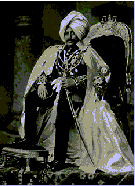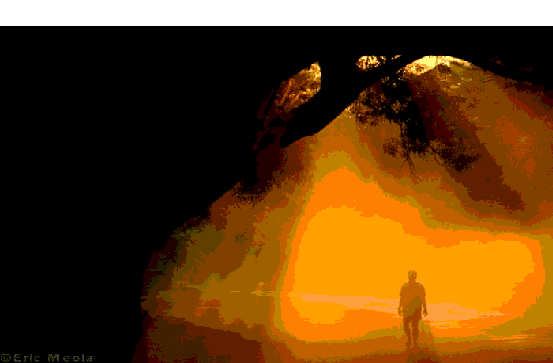|
|
|

I would like to thank all the Internet resources I used to put this project together.
All mentioned in here are Copyrighted to their writers.
Edited by Thunder

India will change you.... Its very name stirs the imagination holding out the promise of astonishments, great spectacles and sudden challenges to preconceptions. All journeys to this vast and varied land are dramatic, unbelievable adventures. India pays enduring dividents to travelers who come taking things in their stride, keeping in mind Kipling's admonition, "A fool lies here, who tried to hustle the mighty East".
India is not for everybody; it's neither bland not always comfortable. Between ancient and modern, rich and poor, lives a remarkable spectrum of humanity, a wonderful tapestry of cultures, languages, religions and costumes forming an heterogeneity exotically interweaved by the mesh of the caste system.
You are always unprepared for India. Like we are always unprepared to challenge ourselves to a face-to-face dwell with no witnesses. Ji ha, India will change you.

Nothing here is ever what it seems. The tattiest building can hide inner walls inlaid with precious stones. The man in the cotton pajama suit may be a clerk or a milkman or a cabinet minister. People weave silk but prefer nylon; hinduism counts making money (the right way) as a sacred duty, but succesful men freely give up all wordly goods and become wandering s a d h u s.
India is mellow with the ageing elegance of ancient civilizations; she is raw with the abrasiveness of newly independent power. heart-stopping beauty and spiritual purity cloak heart-rending poverty and cruelty; Physical squarol can hide the souls of saints. She will inflame and overpower the senses, bombarding them with sights and sounds and smells to feast and sicken. She is confusing and frustrating, inspiring and uplifting. You will return home bemused, and whether you loved or loathed the country, you will never be quite the same again...

"This is indeed India! The land of dreams and romance, of fabulous wealth and fabulous poverty, of splendor and rags, of palaces and hovels, of famine and pestilence, of genii and giants and Aladdin lamps, of tigers and elephants, the cobra and the jungle, the country of a hundred nations and a hundred tongues, of a thousand religions and two million gods, cradle of the human race, birthplace of human speech, mother of history, grandmother of legend, great-grandmother of Tradition... the one land all men desire to see, and having once seen, by even a glimpse, would not give that glimpse for the shows of all the rest of the globe combined."
(Mark Twain - More Tramps Abroad)


Also called Chaula or Chudakarma, this is the ceremony in which a child's head is shaved for the first time, leaving a tuft on the crown. 'Chuda' refers to this tuft. This ceremony is also commonly called 'mundan' in the north.
This sanskara developed for reasons of physical hygiene. Usually performed when the child is approximately three years old, it is believed to have the power to cleanse the body and soul.
The hair on a child's head when he emerges from the womb is considered impure and must be shaved off to make way for the strong, clean hair that grows thereafter. In addition, to shave the head, a razor or other sharp
instrument was required. Chudakarana is also a symbolic release of the child from his mother. Usually by three, the child is no longer being nursed by the mother, and is no longer physically dependent on her. During the Chudakarana, even the hair that he was born with is removed. Therefore this ceremony is believed to mark the point in the child's life when the mother's influence is reduced, and the influence of the father becomes dominant. With the father's influence, the child's education is also believed to begin.
A muhurta and a suitable location (the temple, the home, or the banks of a river) are selected. Brahmins, relatives, and friends are invited to attend.
On the appointed day, the child is bathed and dressed in new clothes. The
mother sits with the child to the west of the sacrificial fire. The father
stands to the right of the mother and offers oblations to the fire. He then
pours warm water into a container of cold water, saying, 'With the warm
water come hither, Vayu, Aditi, cut the hair.' Then the father rubs some
butter or ghee on the right side of the child's head and inserts three stalks
of kusha grass into the child's hair saying, 'Oh herb, protect him, do not
inflict pain on him.' He takes a razor and telling it to be friendly and gentle,
he cuts a little hair from both sides of the child's head, while reciting the
requisite mantras. The cut hair is placed on a mound of bull dung. The
razor is then given to the barber to complete the task.
The entire head is shaved clean, but for a few tufts of hair (Shikha) left on
the crown. The number of the tufts left on the head is determined by family
tradition. For example, the descendants of Sage Vasishtha keep one tuft,
those of Sage Atri and Sage Kashyapa retain two tufts and so on.
According to Sushruta, the reason that a few tufts are left on the head is
that at the crown, an artery joins a critical nerve juncture. Since an injury to
this part of the head is believed to be fatal, the tuft is retained to protect
the area. After the hair is shaved off, it is collected and mixed with bull
dung and either thrown into a river or buried. This is done so that no one
can use the hair in sorcery to harm the child.
After the ceremony is over, the Brahmins, relatives, and friends are fed
and given gifts.
The concept of Chudakarana was known during the Vedic period. This is
apparent because of the Vedic mantras specified to be recited during the
ceremony.
The rules and procedures for performing the Chudakarana are
established in the Grihyasutras. They say this ceremony should be
performed when the child is between one and three years old but can take
place any time upto the seventh year.
Chudakarana is the first ceremony when various other factors are also
considered before performing the ceremony. For example, a muhurta is
chosen for the ceremony. However, if the mother is pregnant or
menstruating on that day, the ceremony should be postponed. It is
believed that it should be performed before the fifth month of the mother's
pregnancy, if she is expecting again at that time, to spare her the fatigue
of sitting through the ceremony - and to protect her unborn child from the
antics of the older child whom she must hold on her lap during
Chudakarana.
According to the Grihyasutras, Chudakarana is also performed for girls,
but without the recitation of Vedic mantras. However, it is believed that it
should not be performed when the child is an even-numbered age, such
as two or four years old because even numbers are considered less
auspicious then odd numbers.
While 'mundan' or 'mottai' is still very popular, the shikha is rarely retained
nowadays. Usually this sanskara is performed along with the
Upanayanam.




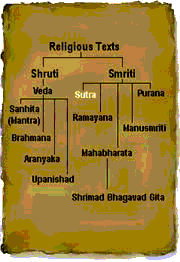
'Thread or string'. These texts form the last stage of Vedic literature, with verses written in very technical language, by different writers between 500 and 200 BC. These works developed as a result of the need to simplify the rites and rituals explained in the Brahmanas. These concise treatises simplify Vedic teachings on rituals and their reasons.
They also simplify the concepts of customary law. They are known as the "angas" or limbs of the four Vedas, but are considered smriti.
There are three known groups of text called sutras: Shrautasutras, Grihyasutras and Dharmasutras, together known as the Kalpa
Sutra, and are considered attached to the Vedas.(Outside the Kalpa
Sutras are other independent texts, not attached to the Vedas, also called Dharmasutra and Grihyasutras)
The Shrautasutras contain short passages of instruction for the
performance of the elaborate rituals described in the Vedas.
The authors of the Shrautasutras belonged to different schools of
philosophy. Some of the important Shrautasutra works are:
The Ashvalayana and Sankhayana, associated with the Rig Veda.
The Jaimini, Manasaka, Latyayana, and Drahyayana, associated with the
Sama Veda.
The Baudhayana, Manava, Bharadvaja, Apastamba and Hiranyakesin,
associated with the black Yajur Veda.
The Katyayana, associated with the white Yajur Veda.
The Kaushitaki and Vaitana, associated with the Atharva Veda.
The Grihyasutras deal with household ceremonies or other rites
performed with the domestic fire in daily life. As a rule, these ceremonies
are not performed by priests but by the householder himself. The
Grihyasutras instruct on both the household ceremonies and on
sanskaras. They explain the ritual, the mantras used and the social
aspects of the sanskaras. Most Grihyasutras begin with an explanation of
the marriage ceremony. Some leave out funeral rites as a sanskara since
the ceremony is considered inauspicious. Some of the important
Grihyasutras are the Apastamba Grihyasutra, the Baudhayana
Grihyasutra, the Ashvalayana Grihyasutra, the Sankhayana Grihyasutra,
and the Gobhila Grihyasutra. The contents of all these texts are similar,
with minor differences in the performance of the ceremonies, since the
authors belonged to different schools of philosophy.
The Dharmasutra deal with the rules of conduct and law. They are the
oldest sources of Hindu law, with a chiefly religious point of view. They are
closely related to the Vedas, from which they quote. Some important
Dharmasutras are:
The Gautama Dharmasutra, which has rules for interpreting texts, details
about the ashrams, especially rules of conduct for the householder and
information on the sanskaras, particularly the Upanayanam. It is one of the
oldest Dharmasutras, and is studied by the followers of the Sama Veda.
The Baudhayana Dharmasutra describes the differences in the religious
practices followed in northern and southern India, and provides detailed
information about the four castes, and the five daily sacrifices
(Panchamahayagya). It is studied by the followers of the black Yajur Veda.
The Apastamba Dharmasutra enumerates the five unpardonable sins, and
discusses certain technical terms and doctrines of Mimansa. It is
considered to be part of the black Yajur Veda.
Certain other sources divide the Sutras into six categories, known as the
Vedangas or limbs of the Vedas. They are the Shiksha, which describes
phonetics; the Chandanas, which details metre and poetic rhythm; the
Vyakarana, which deals with grammar; the Nirukta, which discusses
etymology; the Kalpa, which explains religious practices; and the Jyotishi,
which explains astronomy.
The first four works contribute to the correct recitation and understanding
of the sacred texts. The last two deal with religious rites and duties and the
appropriate seasons for their performance. A Brahmin must mention the
sutra his family is associated with, while formally introducing himself with
the 'Abhivadaye'.
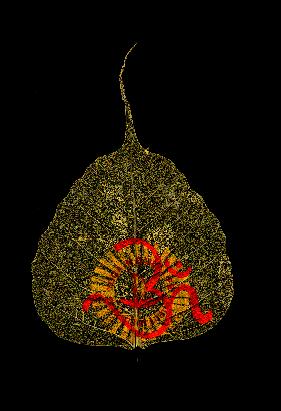
Nativity chart; horoscope scroll, which records the year, month, date, tithi,
configuration and relative position of the planets, stars and constellations
at the time of birth. It also contains the name of the person and acts as a
table of fortune throughout life.
Most people believe that the destiny of a person is affected by the position
of the stars and other heavenly bodies at the moment of birth. Therefore
extreme care is taken to note the exact time of birth to make a correct
janmapatri. This janmapatri is made by the priest or jyotishi whose trade it
is. He makes it by consulting the almanac and making mathematical and
astronomical calculations. It is first read out during the naming ceremony
or namakarana of the child. It tells of favourable and unfavourable periods
in a person's life, his profession, character, marriage and progeny.
Many factors are considered to determine the fate of a person. The
janmapatri gives the position of various planets and the zodiac (rashis) at
the time of birth. By comparing the astral positions at birth with those of
the present and future, the compatibility of the two can be judged and the
future predicted. The various combinations of the zodiac, planets and time
units determine the good or bad result of an event, should it then occur.
The janmapatri is used in all spheres of a person's life. With its help, the
yearly horoscope (varshaphala) is made which tells of the year ahead. Its
most important use, however, is before a marriage when the horoscopes
of the prospective bride and groom are matched. Astral incompatibility
precludes marriage.
A janmapatri is depicted as either a circle or square with 12 'houses' or
"ghara", numbered from one to twelve. Each house represents one sign of
the zodiac.
The earth revolving on its axis goes around all the 12 signs of the zodiac in
one day. It takes about two hours to cross from one sign to the next.
The sign rising on the horizon at the time of one's birth is the "lagna",
which is also the first house of the janmapatri. The subsequent houses are
occupied by the signs of zodiac that follow. Thus, if the "lagna" of a person
is Cancer, it would occupy the first house. The second house would be
occupied by Leo and so on. It is the "lagna rashi" that determines the
character and qualities of a person.
Each zodiac sign is classified as movable (chara), stationary (sthira), or of
both characters (dvisvabhava). They are also classified as mild (saumya),
fierce (krura), powerful during the day (dinabala), and powerful at night
(nishabala). If a person's "lagna" is Leo, he is said to be of fixed character
and so on.
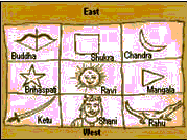
At the time of one's birth, every planet except Rahu and Ketu is in one of
the houses. If a planet is present on the "lagna", it is called the major
planet and affects a person the most. Planets are classified as malefic
and beneficial, and each one affects the person accordingly. For instance,
it is believed that a person born under the influence of the sun will possess
an anxious mind, and be subject to disease because the sun is
considered malefic.
Anyone born under the influence of a full moon would possess elephants
and horses, and be powerful, for the moon is beneficial.
A person born under Mars, which is malefic, would be wounded and
oppressed with fear of robbers and fire. Similar beliefs exist about all the
planets.
Every planet has a 'favourite' house and a few which are not congenial.
The planets with their houses are : Sun - Leo; Moon - Cancer; Mars - Aries
and Scorpio; Mercury - Gemini and Virgo; Jupiter - Sagittarius and
Pisces; Venus - Taurus and Libra; Saturn - Capricorn and Aquarius. Rahu
and Ketu do not have a house.
Of the planets, some are more powerful than the others. Natural powers in
ascending order are: Saturn, Mars, Mercury, Jupiter, Venus, Moon and
Sun.
A planet in its own house affects a person positively. However, its
presence in a noncongenial house has a negative effect. If more than one
planet is present in a house, the effect depends on the congeniality
between the planets and that house.
Apart from this, every planet has its period of influence. The influence of
the Sun lasts for eight years bestowing both sorrow and excitement. The
moon's influence, which lasts 15 years, is filled with happiness. Everyone
undergoes a seven-and-a-half year Shani influence, when life is difficult.
Astral conjunctions at birth affect a person's fortune inexorably. For
example, if a person is born with Mars in the seventh house, it is
considered the gravest of misfortunes. Such a person is termed a
'mangali' meaning his Mars planet is very strong. Not only is the person
himself affected, but so is anyone associated with him. Therefore he can
only marry another 'mangali', which nullifies the effect.
The janmapatri is considered extremely important even today. Many
propitiatory pujas are performed to a malefic planet if a person's
janmapatri indicates a bad time ahead, or to overcome astral
incompatibility in a proposed marriage.
